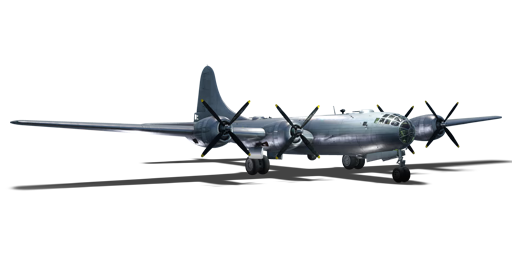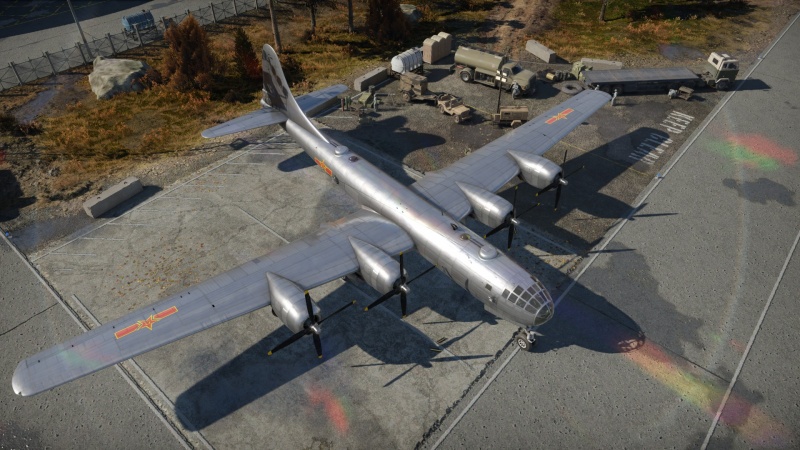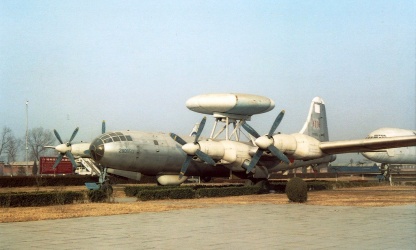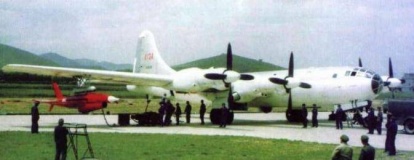Tu-4 (China)
| This page is about the Chinese heavy bomber Tu-4 (China). For other versions, see B-29/Tu-4 (Family). |
Contents
Description
The ␗Tu-4 is a rank Chinese heavy bomber with a battle rating of (AB), (RB), and (SB). It was introduced in Update 1.91 "Night Vision".
General info
Flight performance
| Characteristics | Max Speed (km/h at 9,100 m) |
Max altitude (meters) |
Turn time (seconds) |
Rate of climb (meters/second) |
Take-off run (meters) | |||
|---|---|---|---|---|---|---|---|---|
| AB | RB | AB | RB | AB | RB | |||
| Stock | 618 | 604 | 33.4 | 35.0 | 4.7 | 4.6 | 1,500 | |
| Upgraded | 665 | 641 | 30.4 | 32.0 | 10.5 | 6.5 | ||
Details
| Features | ||||
|---|---|---|---|---|
| Combat flaps | Take-off flaps | Landing flaps | Air brakes | Arrestor gear |
| ✓ | ✓ | ✓ | X | X |
| Limits | ||||||
|---|---|---|---|---|---|---|
| Wings (km/h) | Gear (km/h) | Flaps (km/h) | Max Static G | |||
| Combat | Take-off | Landing | + | - | ||
| 332 | 322 | 270 | ~4 | ~2 | ||
| Optimal velocities (km/h) | |||
|---|---|---|---|
| Ailerons | Rudder | Elevators | Radiator |
| < 340 | < 350 | < 290 | > 400 |
| Compressor | Optimal altitude | 100% Engine power | WEP Engine power |
|---|---|---|---|
| Setting 1 | 10,250 m | 2,200 hp | 2,388 hp |
Survivability and armour
- 60 mm Bulletproof glass in front of the pilots.
- 6.5 mm Steel plates in front of the pilots.
- 6.5 mm Steel plates behind the pilots.
- 6.5 mm Steel plates in front of tail control tractions.
- 6.5 mm Steel plates boxing around rear dorsal gunner and beam gunners.
- 6.5 mm Steel plate behind the rear ventral turret.
- 60 mm Bulletproof glass in front of tail gunner.
- 6.5 mm Steel plate in front of tail gunner.
Do not be fooled even with its powerful defensive armament, it does have weak spots.
While playing the Hunter F 1 or the Vautour IIA, it is easy to send this monster of an aircraft back to base with just one burst. Engaging in a head-on is recommended, as the pilots have little protection, usually knocking them both out.
However, the Tu-4 is a monster of an aircraft in terms of its profile and size, making it very easy to hit. Wings and the tail control are weak spots, so hitting the wings will result in severe wing damage on the Tu-4, forcing it to return to base or even sending it back to the hangar.
While flying the Sabres, try to aim for the fuel tanks in the wings. Most of the time, just set the fuel tanks ablaze, or even blowing off the wing, sending the foe back to the hangar.
Do not engage the Tu-4 from the six! Engaging the Tu-4 at its tail, especially from below, is asking for trouble. Always try to engage the Tu-4 from the top, or in head-ons, the fuselage turrets have dead zones when engaging from >~70 degrees.
Modifications and economy
Armaments
Suspended armament
The Tu-4 (China) can be outfitted with the following ordnance:
- 40 x 100 kg FAB-100 bombs (4,000 kg total)
- 40 x 250 kg FAB-250M43 bombs (10,000 kg total)
- 12 x 500 kg FAB-500 bombs (6,000 kg total)
- 20 x 500 kg FAB-500 bombs (10,000 kg total)
- 8 x 1,000 kg FAB-1000 bombs (8,000 kg total)
- 8 x 1,500 kg FAB-1500M-46 bombs (12,000 kg total)
- 4 x 3,000 kg FAB-3000M-46 bombs (12,000 kg total)
Defensive armament
The Tu-4 (China) is defended by:
- 2 x 23 mm NR-23 cannons, front dorsal turret (275 rpg = 550 total)
- 2 x 23 mm NR-23 cannons, rear dorsal turret (275 rpg = 550 total)
- 2 x 23 mm NR-23 cannons, front ventral turret (250 rpg = 500 total)
- 2 x 23 mm NR-23 cannons, rear ventral turret (500 rpg = 1,000 total)
- 2 x 23 mm NR-23 cannons, tail turret (275 rpg = 550 total)
Usage in battles
The below tactics can be used in all games modes:
Like most planes of its class, the Tu-4 relies on its defensive turrets for aerial combat. A few good hits from its 10 x 23 mm guns can send an attacker back to base, with critical damage or, if not, credit the player with the victory. Maxing out the crew stats is a good idea, it will allow the player to focus more on flying while the AI does the gunning. Don't get too arrogant, remember, the Tu-4 is a huge plane. It is easy to hit, and as mentioned above, especially when the opponents could be jets.
All in all, pay attention to the aircraft's surroundings. The Tu-4 can easily net the team a win so don't let the feeling of invincibility get imbued, or the only reward will be a fiery end.
With this bomber's high battle rating, you should be actively looking out for enemy vehicles. It is possible for an attacker to have a relative closing speed of over 1000 km/h. Relying solely on the spotting system will allow some fighters to get so close it will be impossible for you to react. It is especially common for the enemy to approach either in a 30° cone straight ahead or to trail behind and below you, generally outside gun range before pulling up sharply.
When first starting with this aircraft, the payload option is 40 x 100 kg bombs which are able to destroy numerous bases. One of the best ways to maximize the payload's effectiveness, 15 x 100 kg bombs are needed for one base. The A.I. gunners will be able to defend the plane as bombs are dropped from the bombsight until switching back to the pilot seat, ready to head to next objective. The best option for base bombing is the 8 x 1500 kg payload. A single bomb will be enough to destroy a base, provided you do not miss.
Once the Tu-4's bombing run is complete, start descending towards the friendly airfield; enemy fighters will be hunting for the Tu-4, so be more alert. The Tu-4 has a very powerful defensive system installed with 5 turrets, each with two 2 x 23 mm cannons, so the Tu-4 should be able to defend itself reasonably well. If you believe that landing would be putting the aircraft in grave danger, it is worth considering to instead stay high and shoot down approaching fighters, calling out your position will often lower the stigma associated with this action.
Do not rely on the AI gunners. Most of the time the Tu-4 will face top rank jets including Hunter F 1s and F2 Sabres. These adversaries are usually experienced and will not foolishly tail the bomber for long and try to engage at ranges greater than 1 km or engage in a head-on pass. These manoeuvres render the AI gunners largely useless. Laying down a stream of 23 mm rounds is recommended, but beware of jamming. Hits can be scored within 1.5 - 2 km, if somebody is tailing the Tu-4 or engaging in a head-on pass, they can also occur at greater ranges. Combine the turret shooting with a defensive style of flying to utilize it to its full potential; the Tu-4 offers good handling for its size. Be very careful when putting the Tu-4 into a dive. It is just as prone as any other aircraft to suffering structural damage if its limitations are exceeded. Do not rely on flaps to slow down, their weak construction will let you down.
The two most dangerous opponents of the Tu-4 are the S.O.4050 Vautour IIA and the Hunter F 1. With their 30mm cannons, one burst will be devastating against the Tu-4. The F-86F-2 is also a dangerous opponent, with four 20 mm cannons with a very high velocity and rate of fire.
When down tiered, the most dangerous opponents are the Me 163 B, the Me 262 C-2b and the R2Y2 KAIs. All equipped with 30 mm cannons, they are able to send the Tu-4 back to the hangar within one burst. The 163's and KI-200 extreme mobility are something to be wary of. It isn't uncommon for bomber pilots to lose track of the attacker after a fly by.
Don't underestimate the other Sabres, such as the F-86F-40 and the CL-13A. Their 12.7 mm machine guns can do a lot of damage, crippling or setting the Tu-4 afire, which could end the match for the plane there.
Do not consider any enemy bomber or attacker as a neutral or even friendly party. It is quite common for Canberra's or even B-57's to try and engage you if the opportunity presents itself.
Manual Engine Control
| MEC elements | ||||||
|---|---|---|---|---|---|---|
| Mixer | Pitch | Radiator | Supercharger | Turbocharger | ||
| Oil | Water | Type | ||||
| Controllable | Controllable Auto control available |
Not controllable Not auto controlled |
Controllable Not auto controlled |
Combined | Controllable 1 gear |
Auto controlled |
Pros and cons
Pros:
- This aircraft currently has the highest payload in the game of up to 12,000 kg (26,455 lbs)
- Very strong and fast climber once flight performance modifications have been purchased (compressor, engine, and engine injection)
- Very effective defensive 23 mm turrets that have little dead zones, lots of ammo and great damage
- All payload options are internal and does not create additional drag
- Gunners are located separately from the gun turret with the exception of the tail turret, increasing their survivability
- Tricycle landing gears, does not have to worry about propeller strike
Cons:
- Prone to fires and wing damage, hindering the plane's control
- Will be ripped to shreds by cannons with the calibre of >=20 mm, especially the MK 108 and the ADEN/DEFA 541
- Can face top rank jets such as the Sabre, Hunter and the Vautour
- Unable to reliably defend itself from opponents attacking at once from multiple directions
- Huge aircraft, making it easy to spot from distance and making it close to impossible to miss
- Takes a while to reach an optimal altitude
- Hard to handle/correct direction during landing, due to its low roll rate, slow-responding rudder and slow landing gear movement
History
<--Describe the history of the creation and combat usage of the aircraft in more detail than in the introduction. If the historical reference turns out to be too long, take it to a separate article, taking a link to the article about the vehicle and adding a block "/History" (example: https://wiki.warthunder.com/(Vehicle-name)/History) and add a link to it here using the main template. Be sure to reference text and sources by using <ref></ref>, as well as adding them at the end of the article with <references />. This section may also include the vehicle's dev blog entry (if applicable) and the in-game encyclopedia description (under === In-game description ===, also if applicable).--!>
It’s known that at least twelve Tu-4s were aided to People’s Liberation Army Air Force (PLAAF) by USSR since 1953, making China the only Tu-4 operator outside of the USSR. Ten Tu-4s delivered by the end of 1953 were operated by the Fourth Independent Regiment of PLAAF and later, in 1960, two additional aircraft were aided and served as navigational training aircraft.
The gunship variant
At late 1950s, a few Tu-4s in PLAAF were modified to all-weather interceptors. The forward turret was replaced by a rotatable searchlight and a RP-5 radar from Mig-17PF was installed. The modified Tu-4 can also carry intercept command group as an airborne control plane. According to the plan, the modified Tu-4 can long-time track the P2V-7U reconnaissance aircraft of the ROCAF (operated by the United States) at night. For the fact that reconnaissance aircraft usually conduct recon missions at low altitude and low speed, the modified Tu-4 were planned to operate as gunships, using defensive turrets to take down enemy aircraft.
A brand-new platform
Due to the lack of endurance of the original Ash-73TK piston engine, the remaining Chinese Tu-4 at 1970s installed the new WJ-6 (“渦槳-6”, Turboprop-6) turboprop engines and J17G-13 four-bladed propellers (domestic imitation of AI-20 engine and AV-68 propeller). The 4250 horsepower WJ-6 is more powerful than the original piston engine and a one-piece ventel fin or two small endplate fins at the tips of the horizontal tail were mounted to improve horizonal stability of maneuver characteristic. Meanwhile, all of the defensive turrets on these modified Tu-4s were removed for better performance.
At that time, the Tu-4 is the optimal heavy-weight long-range air platform operated by PLAAF, so a turboprop Tu-4 (series number 2806501, Red 4114) was chosen as the airframe of ‘Plane 926’, first airborne early warning and control (AEW&C) plane of PLAAF. A huge rotodome, which hold the Type 843 radar, was mounted on its center station of the wings and some small antennas were installed on the fuselage, The project started at 1969 and later be called as KJ-1 (“空警一號”, AWACS No.1). The KJ-1 ushered its first test flight in November, 1971. However, the Type 843 radar was found lack of the ability to detect and track low alt flying object during the test, so the whole KJ program was disbanded by 1979. Currently the KJ-1 was in public display in Chinese Aviation Museum, Beijing. Another three Tu-4s with turboprop engines were modified as ECM plane or ELINT plane.
During the Vietnam War, China captured serval wrecks of Ryan BQM-34 reconnaissance drones and one of them was fixed, becoming the sample of reverse-engineering. The resulting product, called Changhong-1 (“長虹一號”, Skylight No.1) or WZ-5 (“無偵-5”, Unmanned reconnaissance aircraft No.5) was built based on the BQM-34. A modified Tu-4(series number 225008, Red 4134) with turboprop engines was converted into a drone carrier platform. The red 4131 drone platform is capable carry two Changhong-1s under the pylons mounted underwing. It can also carry two La-17K UAV.
Media
Excellent additions to the article would be video guides, screenshots from the game, and photos.
See also
Links to the articles on the War Thunder Wiki that you think will be useful for the reader, for example:
- reference to the series of the aircraft;
- links to approximate analogues of other nations and research trees.
External links
| Tupolev Design Bureau (Ту́полев Опытное конструкторское бюро) | |
|---|---|
| Bombers | TB-3M-17-32 · SB 2M-100 · SB 2M-103 MV-3 · SB 2M-103 · SB 2M-103U · SB 2M-103U MV-3 · SB 2M-105 |
| Tu-2 · Tu-2S · Tu-2S-44 · Tu-2S-59 · Tu-4 | |
| Arkhangelsky Bomber | Ar-2* |
| Strike Aircraft | Tu-1 |
| Jet Bomber | Tu-14T |
| Export | ␗SB 2M-103U · ␗Tu-2S-44 · ␗Tu-4 |
| ◔Tu-2S-59 | |
| * While Andrei Tupolev was imprisoned, Alexander Arkhangelsky, second in command at Tupolev OKB was able to append his name to the final production series of the SB bomber. | |
| China bombers | |
|---|---|
| American | Martin 139WC*(␗B-10B) · ␗A-29 · ␗B-25J-30 · ␗PB4Y-2 |
| German | ␗Hs 123 A-1 |
| Soviet | ␗SB 2M-103U · ␗DB-3A · ␗Tu-2S-44 · ␗Tu-4 |
| Japanese | ␗P1Y1 mod. 11 |
| *Export Name | |







